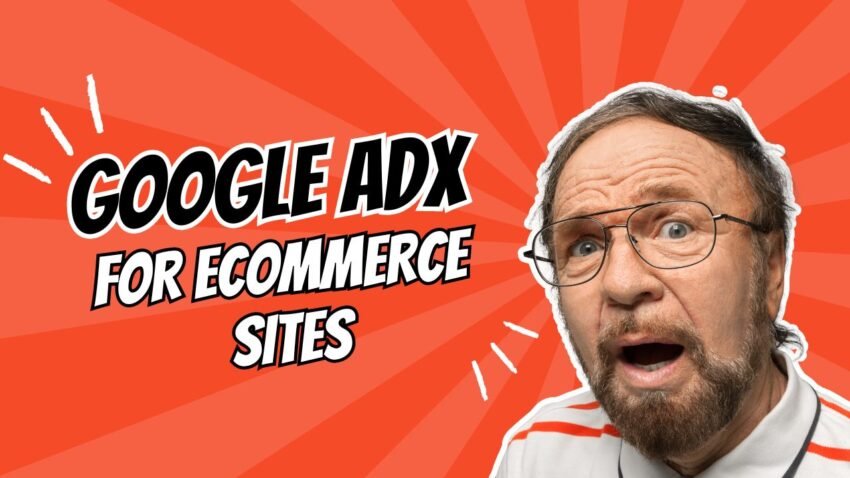
Google AdX for E-commerce Sites: Strategies for Success
In the vast realm of e-commerce, standing out amidst the digital noise can be a daunting challenge. With countless online stores vying for attention, how can you ensure that your e-commerce site gets noticed? Enter Google AdX, a powerful tool that can revolutionize your advertising game and drive success for your online business. In this article, we’ll delve into effective strategies for leveraging Google AdX to propel your e-commerce site to new heights of success.
Read Now: Monitize Video Content In Adx
Understanding Google AdX
Google AdX, short for Google Ad Exchange, is an ad exchange platform that connects advertisers with publishers to facilitate the buying and selling of ad inventory. Think of it as a marketplace where advertisers bid for ad space on various websites, including e-commerce sites. By tapping into the vast network of publishers within the Google ecosystem, AdX enables advertisers to reach a wide audience and maximize their ad exposure.
Here’s a breakdown of how it works:
- Publisher Integration: Publishers integrate AdX into their ad serving system, allowing AdX to compete with other ad networks and ad exchanges to fill ad slots on their website or app.
- Ad Inventory: Publishers offer ad space (inventory) on their digital properties. This could be in the form of banner ads, video ads, interstitials, etc.
- Advertiser Demand: Advertisers, through Demand Side Platforms (DSPs) or other buying platforms, submit bids for ad impressions in real-time auctions. They specify criteria such as the type of audience they want to target, the context of the ad placement, and the maximum bid they’re willing to pay.
- Real-time Auction: When a user visits a webpage or app with available ad space, an auction is triggered. AdX sends bid requests to multiple advertisers, including those using Google Ads, to compete for that ad space.
- Ad Serving Decision: AdX evaluates the bids received and selects the highest bidder in real-time. The winning ad is then served to the user.
- Ad Display: The winning ad is displayed on the webpage or app, generating revenue for the publisher and exposure for the advertiser.
Key features and benefits of Google AdX include:
- Higher Revenue Potential: AdX often provides higher CPMs (Cost Per Thousand Impressions) compared to traditional ad networks due to its large pool of advertisers and real-time bidding.
- Access to Premium Inventory: AdX gives advertisers access to premium inventory from high-quality publishers, which may not be available through other ad networks.
- Advanced Targeting Options: Advertisers can target specific audiences based on demographics, interests, browsing behavior, and more, increasing the effectiveness of their campaigns.
- Real-time Reporting and Optimization: Advertisers and publishers can access real-time reports and analytics to monitor performance and optimize their campaigns for better results.
- Brand Safety and Quality Control: AdX employs various measures to ensure brand safety and prevent fraudulent activity, providing a secure environment for both advertisers and publishers.
Overall, Google AdX is a powerful tool for both advertisers and publishers, offering advanced targeting capabilities, real-time auctions, and access to premium inventory to maximize ad revenue and campaign effectiveness.
Benefits of Google AdX
Google AdX, or Google Ad Exchange, offers several benefits for publishers looking to maximize their ad revenue and for advertisers seeking to reach their target audiences effectively. Here are some key benefits:
- Increased Revenue Potential: AdX allows publishers to access a vast pool of advertisers bidding on their ad inventory in real-time through programmatic buying. This competition often leads to higher CPMs (Cost Per Thousand Impressions) and increased revenue compared to traditional ad networks.
- Access to Premium Advertisers: AdX attracts premium advertisers and agencies, including those who utilize Google Ads (formerly AdWords) and DoubleClick Bid Manager. Publishers can leverage these relationships to secure higher-quality ads and premium rates.
- Real-Time Bidding (RTB): AdX operates on a real-time bidding model, enabling advertisers to bid on impressions as they become available. This dynamic auction system ensures that ad inventory is sold at the highest possible price at any given moment.
- Granular Targeting Options: AdX offers advanced targeting capabilities, allowing advertisers to reach specific audiences based on demographics, interests, behaviors, and more. This precision targeting enhances ad relevance, which can lead to higher engagement and conversion rates.
- Optimized Ad Delivery: Google’s sophisticated algorithms optimize ad delivery based on factors like user behavior, device type, geography, and website context. This optimization maximizes the effectiveness of ads while minimizing intrusiveness, improving the overall user experience.
- Unified Management: AdX integrates seamlessly with other Google advertising products, such as AdSense, DoubleClick for Publishers (DFP), and Google Ad Manager. This unified platform streamlines ad management, reporting, and revenue tracking for publishers, providing a comprehensive solution for monetizing digital content.
- Brand Safety and Ad Quality: Google employs robust measures to ensure brand safety and maintain ad quality across its network. AdX utilizes automated and manual processes to screen ads for relevance, appropriateness, and compliance with advertising policies, protecting both publishers and advertisers from harmful or inappropriate content.
- Data Insights and Reporting: AdX provides publishers with detailed analytics and reporting tools to track ad performance, revenue metrics, and audience behavior. These insights enable publishers to make informed decisions about ad placements, content strategies, and audience targeting to optimize their monetization efforts.
Overall, Google AdX offers publishers and advertisers a powerful platform for monetizing digital content and reaching their respective goals efficiently and effectively.
Targeting the Right Audience
Effective audience targeting is key to the success of your Google AdX campaigns. Utilize the robust targeting options offered by AdX to hone in on your ideal audience based on demographics, interests, browsing behavior, and more. By targeting the right audience, you can maximize the relevance of your ads and increase the likelihood of driving conversions.
Optimizing Ad Creatives
Your ad creatives play a crucial role in capturing the attention of your target audience and enticing them to take action. Invest time and resources into creating compelling ad creatives that are visually appealing, relevant to your target audience, and aligned with your brand identity. Test different creatives to identify what resonates best with your audience and optimize accordingly.
Monitoring and Analytics
Continuous monitoring and analysis of your Google AdX campaigns are essential for identifying areas of improvement and maximizing performance. Leverage the analytics tools provided by AdX to track key metrics such as click-through rates, conversion rates, and return on investment. Use this data to make informed decisions and refine your advertising strategies for optimal results.
A/B Testing for Success
A/B testing, also known as split testing, involves comparing two versions of an ad to determine which performs better. Experiment with different ad formats, messaging, and calls-to-action to identify what resonates most with your audience. By conducting A/B tests, you can fine-tune your ads and improve their effectiveness over time.
Read About: Boost Your Adx Revenue
Budgeting Wisely
Effective budgeting is essential for maximizing the impact of your Google AdX campaigns. Set clear budgetary goals based on your advertising objectives and allocate your budget strategically across campaigns. Monitor your spending closely and adjust your budget allocation as needed to ensure that you’re getting the most bang for your buck.
Ad Placement Strategies
Where your ads are placed can have a significant impact on their performance. Experiment with different ad placements within the Google AdX network to identify which positions yield the best results for your e-commerce site. Consider factors such as visibility, relevance, and user experience when selecting ad placements.
Mobile Optimization
In today’s mobile-centric world, optimizing your ads for mobile devices is non-negotiable. Ensure that your ad creatives are designed to display seamlessly on smartphones and tablets, and optimize your landing pages for mobile users. By prioritizing mobile optimization, you can tap into the growing base of mobile shoppers and maximize the effectiveness of your Google AdX campaigns.
Retargeting Strategies
Retargeting allows you to re-engage with users who have previously visited your e-commerce site but did not make a purchase. Implement retargeting strategies within your Google AdX campaigns to remind these users of your products or services and encourage them to complete their purchase. By staying top-of-mind with potential customers, you can increase conversion rates and drive sales.
Conclusion
In conclusion, Google AdX offers a wealth of opportunities for e-commerce sites looking to elevate their advertising efforts. By understanding the platform’s capabilities and implementing effective strategies, you can maximize the impact of your ads and drive success for your online business.
Frequently Asked Questions
- How does Google AdX differ from Google Ads?Google AdX is an ad exchange platform that connects advertisers with publishers to buy and sell ad inventory, whereas Google Ads is a platform for creating and managing online advertising campaigns across various Google properties.
- Can small e-commerce sites benefit from Google AdX?Yes, small e-commerce sites can benefit from Google AdX by gaining access to premium ad inventory and reaching a wider audience through targeted advertising campaigns.
- How much does it cost to advertise on Google AdX?The cost of advertising on Google AdX varies depending on factors such as ad placement, targeting options, and competition. Advertisers bid on ad impressions in real-time, so costs can fluctuate based on demand.
- Is Google AdX suitable for all types of e-commerce businesses?While Google AdX can be beneficial for many e-commerce businesses, it may not be the best fit for all. Factors such as budget, target audience, and advertising objectives should be considered when determining suitability.
- How can I measure the success of my Google AdX campaigns?You can measure the success of your Google AdX campaigns by tracking key metrics such as click-through rates, conversion rates, and return on investment. Utilize the analytics tools provided by AdX to monitor performance and make data-driven decisions.








Leave a Reply